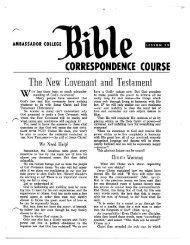Crucifixion Was Not on Friday (1968)_b.pdf - Herbert W. Armstrong
Crucifixion Was Not on Friday (1968)_b.pdf - Herbert W. Armstrong
Crucifixion Was Not on Friday (1968)_b.pdf - Herbert W. Armstrong
You also want an ePaper? Increase the reach of your titles
YUMPU automatically turns print PDFs into web optimized ePapers that Google loves.
The <str<strong>on</strong>g>Crucifixi<strong>on</strong></str<strong>on</strong>g> <str<strong>on</strong>g>Was</str<strong>on</strong>g> <str<strong>on</strong>g>Not</str<strong>on</strong>g> <strong>on</strong> <strong>Friday</strong> 29<br />
beginning of A.D. 28, just before the first Passover in Jesus'<br />
ministry.<br />
If the ministry of Christ began in any other year than the<br />
autumn of A.D. 27, then the temple would not have been<br />
exactly 46 years in building by the time of the Passover in the<br />
spring of 28 A.D.<br />
Proof Five: The Reign of Emperor Tiberius<br />
One of the most vital keys to the chr<strong>on</strong>ology of Christ's<br />
ministry - and yet <strong>on</strong>e of the most universally misunderstood<br />
dates - is the 15th year of the reign of Tiberius Caesar. Luke<br />
tells us that John the Baptist began to preach in his 15th year<br />
(Luke 3: 1).<br />
When was this fifteenth year?<br />
The trouble arises from the fact that there are at least<br />
two dates from which the reign of Tiberius Caesar may be<br />
counted - the first commences with his being made co-ruler<br />
with Augustus Caesar, at the very end of A.D. 11 or the beginning<br />
of A.D. 12. The exact m<strong>on</strong>th is not known, but it is<br />
not essential anyway. The sec<strong>on</strong>d date begins with his sole rule<br />
in August, A.D. 14. Luke could have used either date and been<br />
historically correct. But which <strong>on</strong>e did he use?<br />
To be c<strong>on</strong>sistent with all the other facts, Luke must have<br />
used the earlier date as the beginning of the reign of Tiberius.<br />
In fact, for the word "reign" Luke uses a Greek word meaning<br />
"government" in general, indicating that he did not mean his<br />
sole emperorship, but merely his elevati<strong>on</strong> to joint authorityabout<br />
the end of A.D. 11 or beginning of A.D. 12.<br />
In determining the emperor's regnal year, Luke used the<br />
customary Jewish form, practiced also by Josephus. "Josephus<br />
also . . . in order to avoid making the last year of <strong>on</strong>e emperor<br />
coincide with the first year of his successor, reck<strong>on</strong>ed the final<br />
year of each emperor as c<strong>on</strong>tinuing to the end of the current<br />
year, and made the first year of his sucessor begin [in] April<br />
following his accessi<strong>on</strong>," says the competent scholar W. M.<br />
Ramsey in his book <str<strong>on</strong>g>Was</str<strong>on</strong>g> Christ Born at Bethlehem?, page 223.<br />
This method which has but recently been understood, was<br />
used by Luke also to determine imperial joint reigns. The first

















